
Rangaku
Encyclopedia
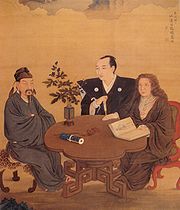
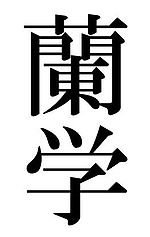
Japan
Japan is an island nation in East Asia. Located in the Pacific Ocean, it lies to the east of the Sea of Japan, China, North Korea, South Korea and Russia, stretching from the Sea of Okhotsk in the north to the East China Sea and Taiwan in the south...
through its contacts with the Dutch enclave of Dejima
Dejima
was a small fan-shaped artificial island built in the bay of Nagasaki in 1634. This island, which was formed by digging a canal through a small peninsula, remained as the single place of direct trade and exchange between Japan and the outside world during the Edo period. Dejima was built to...
, which allowed Japan to keep abreast of Western
Western world
The Western world, also known as the West and the Occident , is a term referring to the countries of Western Europe , the countries of the Americas, as well all countries of Northern and Central Europe, Australia and New Zealand...
technology
Technology
Technology is the making, usage, and knowledge of tools, machines, techniques, crafts, systems or methods of organization in order to solve a problem or perform a specific function. It can also refer to the collection of such tools, machinery, and procedures. The word technology comes ;...
and medicine
Medicine
Medicine is the science and art of healing. It encompasses a variety of health care practices evolved to maintain and restore health by the prevention and treatment of illness....
in the period when the country was closed to foreigners, 1641–1853, because of the Tokugawa shogunate
Tokugawa shogunate
The Tokugawa shogunate, also known as the and the , was a feudal regime of Japan established by Tokugawa Ieyasu and ruled by the shoguns of the Tokugawa family. This period is known as the Edo period and gets its name from the capital city, Edo, which is now called Tokyo, after the name was...
’s policy of national isolation (sakoku
Sakoku
was the foreign relations policy of Japan under which no foreigner could enter nor could any Japanese leave the country on penalty of death. The policy was enacted by the Tokugawa shogunate under Tokugawa Iemitsu through a number of edicts and policies from 1633–39 and remained in effect until...
).
Through Rangaku, Japan learned many aspects of the scientific and technological revolution
Scientific revolution
The Scientific Revolution is an era associated primarily with the 16th and 17th centuries during which new ideas and knowledge in physics, astronomy, biology, medicine and chemistry transformed medieval and ancient views of nature and laid the foundations for modern science...
occurring in Europe
Europe
Europe is, by convention, one of the world's seven continents. Comprising the westernmost peninsula of Eurasia, Europe is generally 'divided' from Asia to its east by the watershed divides of the Ural and Caucasus Mountains, the Ural River, the Caspian and Black Seas, and the waterways connecting...
at that time, helping the country build up the beginnings of a theoretical and technological scientific base, which helps to explain Japan’s success in its radical and speedy modernization following the opening of the country to foreign trade in 1854.
History

Netherlands
The Netherlands is a constituent country of the Kingdom of the Netherlands, located mainly in North-West Europe and with several islands in the Caribbean. Mainland Netherlands borders the North Sea to the north and west, Belgium to the south, and Germany to the east, and shares maritime borders...
traders at Dejima
Dejima
was a small fan-shaped artificial island built in the bay of Nagasaki in 1634. This island, which was formed by digging a canal through a small peninsula, remained as the single place of direct trade and exchange between Japan and the outside world during the Edo period. Dejima was built to...
in Nagasaki were the only European foreigners tolerated in Japan from 1639 till 1853 (the Dutch had a trading post in Hirado from 1609 till 1641 before they had to move to Dejima), and their movements were carefully watched and strictly controlled, being limited initially to one yearly trip to give their homage to the Shogun
Dutch missions to Edo
The Dutch East India Company missions to Edo were regular tribute missions to the court of the Tokugawa Shogun in Edo to reassure the ties between the Bakufu and the Opperhoofd...
in Edo. They became instrumental, however, in transmitting to Japan some knowledge of the industrial
Industrial Revolution
The Industrial Revolution was a period from the 18th to the 19th century where major changes in agriculture, manufacturing, mining, transportation, and technology had a profound effect on the social, economic and cultural conditions of the times...
and scientific revolution
Scientific revolution
The Scientific Revolution is an era associated primarily with the 16th and 17th centuries during which new ideas and knowledge in physics, astronomy, biology, medicine and chemistry transformed medieval and ancient views of nature and laid the foundations for modern science...
that was occurring in Europe: The Japanese purchased and translated numerous scientific books from the Dutch, obtained from them Western curiosities and manufactures (such as clocks), and received demonstrations of various Western innovations, such as the demonstrations of electric phenomena, and the flight of a hot air balloon in the early 19th century. In the 17th and 18th centuries, the Dutch were the most economically wealthy and scientifically advanced of all European nations, which put them in a privileged position to transfer Western knowledge to Japan.
Altogether, thousands of such books were published, printed, and circulated. Japan already had at that time one of the largest urban populations in the world, with more than one million inhabitants in Edo, and many other large cities such as Osaka and Kyoto, offering a large, literate market to such novelties. In the large cities some shops, open to the general public, specialized in foreign curiosities.
Beginnings (1640–1720)
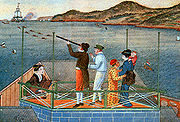
Kirishitan
, from Portuguese cristão, referred to Roman Catholic Christians in Japanese and is used as a historiographic term for Roman Catholics in Japan in the 16th and 17th centuries. Christian missionaries were known as bateren or iruman...
in Japan in 1640. Initially, a small group of hereditary
Heredity
Heredity is the passing of traits to offspring . This is the process by which an offspring cell or organism acquires or becomes predisposed to the characteristics of its parent cell or organism. Through heredity, variations exhibited by individuals can accumulate and cause some species to evolve...
Japanese–Dutch translators labored in Nagasaki to smooth communication with the foreigners and transmit bits of Western novelties.
Also, the Dutch were requested to give updates of world events and to supply novelties to the Shogun every year on their trips to Edo. Finally, the Dutch factories in Nagasaki, in addition to their official trade work in silk and deer hides, were allowed to engage in some level of “private trade”. A small, lucrative market for Western curiosities thus developed, focused on the Nagasaki area. With the establishment of a permanent post for a surgeon at the Dutch trading post Dejima, high ranking Japanese officials started to ask for treatment in cases when local doctors were of no help. One of the most important surgeons was Caspar Schamberger
Caspar Schamberger
Caspar Schamberger was a German surgeon. His name represents the first school of Western medicine in Japan and the beginning of Dutch Studies ....
, who induced a continuing interest in medical books, pharmaceuticals, treatment methods etc.
Liberalization of Western knowledge (1720–)
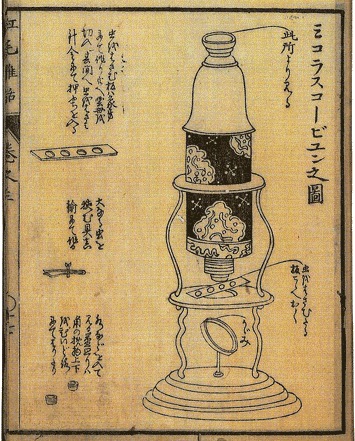
Shogun
A was one of the hereditary military dictators of Japan from 1192 to 1867. In this period, the shoguns, or their shikken regents , were the de facto rulers of Japan though they were nominally appointed by the emperor...
Tokugawa Yoshimune
Tokugawa Yoshimune
was the eighth shogun of the Tokugawa shogunate of Japan, ruling from 1716 until his abdication in 1745. He was the son of Tokugawa Mitsusada, the grandson of Tokugawa Yorinobu, and the great-grandson of Tokugawa Ieyasu.-Lineage:...
in 1 720, which started an influx of foreign books and their translations into Japanese. One example is the 1 787 publication of Morishima Chūryō
Morishima Churyo
was an Edo period Japanese author of popular fiction who also wrote a number of works in the field of rangaku . He wrote under many pen names, including Manzōtei, Shinra Manzō , and Tenjiku Rōjin...
’s , recording much knowledge received from the Dutch. The book details a vast array of topics: it includes objects such as microscope
Microscope
A microscope is an instrument used to see objects that are too small for the naked eye. The science of investigating small objects using such an instrument is called microscopy...
s and hot air balloon
Hot air balloon
The hot air balloon is the oldest successful human-carrying flight technology. It is in a class of aircraft known as balloon aircraft. On November 21, 1783, in Paris, France, the first untethered manned flight was made by Jean-François Pilâtre de Rozier and François Laurent d'Arlandes in a hot air...
s; discusses Western hospitals and the state of knowledge of illness and disease; outlines techniques for painting
Painting
Painting is the practice of applying paint, pigment, color or other medium to a surface . The application of the medium is commonly applied to the base with a brush but other objects can be used. In art, the term painting describes both the act and the result of the action. However, painting is...
and printing with copper plates
Intaglio (printmaking)
Intaglio is a family of printmaking techniques in which the image is incised into a surface, known as the matrix or plate, and the incised line or area holds the ink. Normally, copper or zinc plates are used as a surface, and the incisions are created by etching, engraving, drypoint, aquatint or...
; it describes the makeup of static electricity
Static electricity
Static electricity refers to the build-up of electric charge on the surface of objects. The static charges remain on an object until they either bleed off to ground or are quickly neutralized by a discharge. Static electricity can be contrasted with current electricity, which can be delivered...
generators and large ship
Ship
Since the end of the age of sail a ship has been any large buoyant marine vessel. Ships are generally distinguished from boats based on size and cargo or passenger capacity. Ships are used on lakes, seas, and rivers for a variety of activities, such as the transport of people or goods, fishing,...
s; and it relates updated geographical knowledge
Geography
Geography is the science that studies the lands, features, inhabitants, and phenomena of Earth. A literal translation would be "to describe or write about the Earth". The first person to use the word "geography" was Eratosthenes...
.
Between 1804 and 1829, schools opened throughout the country by the Bakufu as well as terakoya
Terakoya
Terakoya were private educational institutions that taught writing and reading to the children of Japanese commoners during the Edo period.-History:...
helped spread the new ideas further.
By that time, Dutch emissaries and scientists were also allowed much more free access to Japanese society. The German physician von Siebold, attached to the Dutch delegation, established numerous exchanges with Japanese students. He invited Japanese scientists to show them the marvels of Western science, learning, in return, much about the Japanese and their customs. In 1824, von Siebold began a medical school with fifty students, appointed by the Shogun
Shogun
A was one of the hereditary military dictators of Japan from 1192 to 1867. In this period, the shoguns, or their shikken regents , were the de facto rulers of Japan though they were nominally appointed by the emperor...
. They helped with the botanical and naturalistic studies of von Siebold. His school, the , grew into a meeting place for about fifty rangaku-sha (students of rangaku).
Expansion and politicization (1839–)
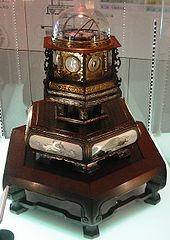
In 1839, scholars of Western studies (called “rangaku-sha”) briefly suffered repression by the Edo Shogunate in the incident, due to their opposition to the introduction of the death penalty against foreigners (other than Dutch) coming ashore, recently enacted by the Bakufu. The incident was provoked by actions such as the Morrison Incident
Morrison Incident
The of 1837 occurred when the American merchant ship, Morrison headed by Charles W. King, was driven away from "sakoku" Japan by cannon fire...
, in which an unarmed American merchant ship was fired upon under the Edict to Repel Foreign Ships. The edict was eventually repealed in 1842.
Rangaku ultimately became obsolete when Japan opened up in the Bakumatsu period, 1853–67. Students were sent abroad, and foreign employees (o-yatoi gaikokujin
O-yatoi gaikokujin
The Foreign government advisors in Meiji Japan, known in Japanese as oyatoi gaikokujin , were those foreign advisors hired by the Japanese government for their specialized knowledge to assist in the modernization of Japan at the end of the Bakufu and during the Meiji era. The term is sometimes...
) came to Japan to teach and advise in large numbers, leading to an unprecedented and rapid modernization of the country.
It is often argued that Rangaku kept Japan from being completely uninformed about the critical phase of Western scientific advancement during the 18th and 19th century, allowing Japan to build up the beginnings of a theoretical and technological scientific base. This openness could partly explain Japan’s success in its radical and speedy modernization following the opening of the country to foreign trade in 1854.
Medical sciences
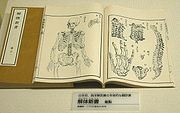
Dissection
Dissection is usually the process of disassembling and observing something to determine its internal structure and as an aid to discerning the functions and relationships of its components....
s. The accuracy of Western learning made a sensation among the population, and new publications such as the of 1759 and the of 1774 became references. The latter was a compilation made by several Japanese scholars, led by Sugita Genpaku
Sugita Genpaku
was a Japanese scholar who was known for his translation of Kaitai Shinsho .Besides Kaitai Shinsho, he also authored Rangaku Kotohajime ....
, mostly based on the Dutch-language Ontleedkundige Tafelen of 1734, itself a translation of Anatomische Tabellen (1732) by the German author Johann Adam Kulmus.
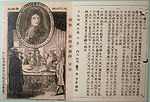
General anaesthesia
General anaesthesia is a state of unconsciousness and loss of protective reflexes resulting from the administration of one or more general anaesthetic agents...
during surgery for breast cancer (mastectomy
Mastectomy
Mastectomy is the medical term for the surgical removal of one or both breasts, partially or completely. Mastectomy is usually done to treat breast cancer; in some cases, women and some men believed to be at high risk of breast cancer have the operation prophylactically, that is, to prevent cancer...
). The surgery involved combining Chinese herbal medicine and Western surgery
Surgery
Surgery is an ancient medical specialty that uses operative manual and instrumental techniques on a patient to investigate and/or treat a pathological condition such as disease or injury, or to help improve bodily function or appearance.An act of performing surgery may be called a surgical...
techniques, 40 years before the better-known Western innovations of Long
Crawford Long
Crawford Williamson Long was an American surgeon and pharmacist best known for his first use of inhaled diethyl ether as an anesthetic...
, Wells
Horace Wells
Horace Wells was an American dentist who pioneered the use of anaesthesia in dentistry, specifically nitrous oxide .-Life:...
and Morton
William T.G. Morton
William Thomas Green Morton was an American dentist who first publicly demonstrated the use of inhaled ether as a surgical anesthetic in 1846. The promotion of his questionable claim to have been the discoverer of anesthesia became an obsession for the rest of his life.- Life and work :Born in...
, with the introduction of diethyl ether
Diethyl ether
Diethyl ether, also known as ethyl ether, simply ether, or ethoxyethane, is an organic compound in the ether class with the formula . It is a colorless, highly volatile flammable liquid with a characteristic odor...
(1846) and chloroform
Chloroform
Chloroform is an organic compound with formula CHCl3. It is one of the four chloromethanes. The colorless, sweet-smelling, dense liquid is a trihalomethane, and is considered somewhat hazardous...
(1847) as general anaesthetics.
In 1838, Dr. Ogata Kōan established the Rangaku school named Tekijuku
Tekijuku
Tekijuku was a school established in Senba Osaka, in 1838 during the Tenpō era of the late Edo period. Its founder was Ogata Kōan, a doctor and scholar of Dutch studies...
. Famous alumni of the Tekijuku include Fukuzawa Yukichi
Fukuzawa Yukichi
was a Japanese author, writer, teacher, translator, entrepreneur and political theorist who founded Keio University. His ideas about government and social institutions made a lasting impression on a rapidly changing Japan during the Meiji Era...
and Ōtori Keisuke
Otori Keisuke
was a Japanese military commander during the last years of the Tokugawa shogunate and the beginning of the Meiji Era.-Early life and education:Ōtori Keisuke was born in Akamatsu Village, in the Akō domain of Harima Province , the son of physician Kobayashi Naosuke...
, who would become key players in Japan’s modernization. He was the author of 1849’s , which was the first book on pathology
Pathology
Pathology is the precise study and diagnosis of disease. The word pathology is from Ancient Greek , pathos, "feeling, suffering"; and , -logia, "the study of". Pathologization, to pathologize, refers to the process of defining a condition or behavior as pathological, e.g. pathological gambling....
to be published in Japan.
Physical sciences
Some of the first scholars of Rangaku were involved with the assimilation of 17th century theories in the physical sciencePhysical science
Physical science is an encompassing term for the branches of natural science and science that study non-living systems, in contrast to the life sciences...
s. This is the case of Shizuki Tadao an eighth-generation descendant of the Shizuki house of Nagasaki Dutch
Dutch language
Dutch is a West Germanic language and the native language of the majority of the population of the Netherlands, Belgium, and Suriname, the three member states of the Dutch Language Union. Most speakers live in the European Union, where it is a first language for about 23 million and a second...
translators, who after having completed for the first time a systematic analysis of Dutch grammar, went on to translate the Dutch edition of Introductio ad Veram Physicam of the British author John Keil on the theories of Newton (Japanese title: , 1798). Shizuki coined several key scientific terms for the translation, which are still in use in modern Japanese; for example, , , , and . A second Rangaku scholar, Hoashi Banri, published a manual of physical sciences in 1810 – – based on a combination of thirteen Dutch books, after learning Dutch from just one Dutch-Japanese dictionary.
Electrical phenomena

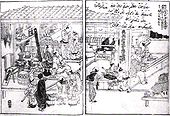
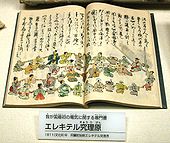
Leyden jar
A Leyden jar, or Leiden jar, is a device that "stores" static electricity between two electrodes on the inside and outside of a jar. It was invented independently by German cleric Ewald Georg von Kleist on 11 October 1745 and by Dutch scientist Pieter van Musschenbroek of Leiden in 1745–1746. The...
in 1745, similar electrostatic generator
Electrostatic generator
An electrostatic generator, or electrostatic machine, is a mechanical device that produces static electricity, or electricity at high voltage and low continuous current...
s were obtained for the first time in Japan from the Dutch around 1770 by Hiraga Gennai
Hiraga Gennai
was an Edo period Japanese pharmacologist, student of Rangaku, physician, author, painter and inventor who is well known for his Erekiteru , Kandankei and Kakanpu...
. Static electricity
Static electricity
Static electricity refers to the build-up of electric charge on the surface of objects. The static charges remain on an object until they either bleed off to ground or are quickly neutralized by a discharge. Static electricity can be contrasted with current electricity, which can be delivered...
was produced by the friction of a glass tube with a gold-plated stick, creating various electrical effects. The jars were reproduced and adapted by the Japanese, who called it . Just as in Europe, these generators were used as curiosities, such as making sparks fly from the head of a subject, or for supposed pseudoscientific medical advantages. In Sayings of the Dutch, the Elekiter is described as a machine that allows one to take sparks out of the human body, in order to treat sick parts. Elekiters were sold widely to the public in curiosity shops. Many electric machines derived from the Elekiter were then invented, particularly by Sakuma Shōzan
Sakuma Shozan
sometimes called Sakuma Zōzan, was a Japanese politician and scholar of the Edo era. He was the son of a samurai, and a native of Shinshu in today's Nagano-ken.From the age of 23, he went to Edo and for 10 years studied Chinese sciences ....
.
Japan’s first electricity manual, by Hashimoto Muneyoshi, published in 1811, describes numerous electrical phenomena, such as experiments with electric generators, conductivity through the human body, and the 1750 experiments of Benjamin Franklin
Benjamin Franklin
Dr. Benjamin Franklin was one of the Founding Fathers of the United States. A noted polymath, Franklin was a leading author, printer, political theorist, politician, postmaster, scientist, musician, inventor, satirist, civic activist, statesman, and diplomat...
with lightning
Lightning
Lightning is an atmospheric electrostatic discharge accompanied by thunder, which typically occurs during thunderstorms, and sometimes during volcanic eruptions or dust storms...
.
Chemistry
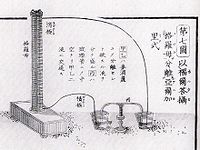
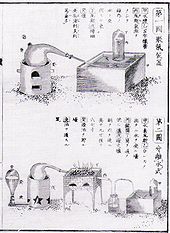
William Henry (chemist)
William Henry was an English chemist.He was the son of Thomas Henry and was born in Manchester England. He developed what is known today as Henry's Law.-Life:...
’s 1799 Elements of Experimental Chemistry. In particular, the book contains a detailed description of the electric battery invented by Volta
Alessandro Volta
Count Alessandro Giuseppe Antonio Anastasio Gerolamo Umberto Volta was a Lombard physicist known especially for the invention of the battery in 1800.-Early life and works:...
forty years earlier in 1800. The battery itself was constructed by Udagawa in 1831 and used in various experiments, including medical ones, based on a belief that electricity could help cure illnesses.
Udagawa’s work also reports for the first time in details the findings and theories of Lavoisier in Japan. Accordingly, Udagawa also made numerous scientific experiments and created new scientific terms, which are still in current use in modern scientific Japanese, like , , , and .
Telescopes
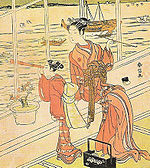
Telescope
A telescope is an instrument that aids in the observation of remote objects by collecting electromagnetic radiation . The first known practical telescopes were invented in the Netherlands at the beginning of the 1600s , using glass lenses...
was offered by the English
England
England is a country that is part of the United Kingdom. It shares land borders with Scotland to the north and Wales to the west; the Irish Sea is to the north west, the Celtic Sea to the south west, with the North Sea to the east and the English Channel to the south separating it from continental...
captain John Saris
John Saris
John Saris was the captain of the first English voyage to Japan, in 1613, on board The Clove. As chief factor of the British East India Company's trading post in Java, Saris' mission was primarily one of seeking trade....
to Tokugawa Ieyasu
Tokugawa Ieyasu
was the founder and first shogun of the Tokugawa shogunate of Japan , which ruled from the Battle of Sekigahara in 1600 until the Meiji Restoration in 1868. Ieyasu seized power in 1600, received appointment as shogun in 1603, abdicated from office in 1605, but...
in 1614, with the assistance of William Adams
William Adams (sailor)
William Adams , also known in Japanese as Anjin-sama and Miura Anjin , was an English navigator who travelled to Japan and is believed to be the first Englishman ever to reach that country...
, during Saris’ mission to open trade between England and Japan. This followed the invention of the telescope by Dutchman Hans Lippershey
Hans Lippershey
Hans Lippershey , also known as Johann Lippershey or Lipperhey, was a German-Dutch lensmaker commonly associated with the invention of the telescope, although it is unclear if he was the first to build one.-Biography:...
in 1608 by a mere six years. Refracting telescope
Refracting telescope
A refracting or refractor telescope is a type of optical telescope that uses a lens as its objective to form an image . The refracting telescope design was originally used in spy glasses and astronomical telescopes but is also used for long focus camera lenses...
s were widely used by the populace during the Edo period
Edo period
The , or , is a division of Japanese history which was ruled by the shoguns of the Tokugawa family, running from 1603 to 1868. The political entity of this period was the Tokugawa shogunate....
, both for pleasure and for the observation of the stars.
After 1640, the Dutch continued to inform the Japanese about the evolution of telescope technology. In 1831, after having spent several months in Edo where he could get accustomed with Dutch wares, Kunitomo Ikkansai
Kunitomo Ikkansai
was a Japanese gun manufacturer of the early 19th century, who, after having spent several months in Edo where he could get accustomed with Dutch wares, built Japan's first reflective telescope in 1831. It was of the Gregorian type....
(a former gun manufacturer) built Japan’s first reflecting telescope
Reflecting telescope
A reflecting telescope is an optical telescope which uses a single or combination of curved mirrors that reflect light and form an image. The reflecting telescope was invented in the 17th century as an alternative to the refracting telescope which, at that time, was a design that suffered from...
of the Gregorian
Gregorian telescope
The Gregorian telescope is a type of reflecting telescope designed by Scottish mathematician and astronomer James Gregory in the 17th century, and first built in 1673 by Robert Hooke...
type. Kunitomo’s telescope had a magnification
Magnification
Magnification is the process of enlarging something only in appearance, not in physical size. This enlargement is quantified by a calculated number also called "magnification"...
of 60, and allowed him to make very detailed studies of sun spot
Sun SPOT
Sun SPOT is a wireless sensor network mote developed by Sun Microsystems. The device is built upon the IEEE 802.15.4 standard...
s and lunar topography. Four of his telescopes remain to this day.
Microscopes
Microscopes were invented in Europe during the 17th century, but it is unclear when exactly they reached Japan. Clear descriptions of microscopes are made in the 1720 and in the 1787 book Saying of the Dutch. Although Europeans mainly used microscopes to observe small cellular organisms, the Japanese mainly used them for entomological purposes, creating numerous detailed descriptions of insectInsect
Insects are a class of living creatures within the arthropods that have a chitinous exoskeleton, a three-part body , three pairs of jointed legs, compound eyes, and two antennae...
s.
Magic lanterns

Magic lanterns, first described in the West by Athanasius Kircher
Athanasius Kircher
Athanasius Kircher was a 17th century German Jesuit scholar who published around 40 works, most notably in the fields of oriental studies, geology, and medicine...
in 1671, became very popular attractions in multiple forms in 18th-century Japan.
The mechanism of a magic lantern, called was described using technical drawings in the book titled in 1779.
Automata
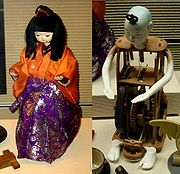
Karakuri are mechanized puppet
Puppet
A puppet is an inanimate object or representational figure animated or manipulated by an entertainer, who is called a puppeteer. It is used in puppetry, a play or a presentation that is a very ancient form of theatre....
s or automata
Automaton
An automaton is a self-operating machine. The word is sometimes used to describe a robot, more specifically an autonomous robot. An alternative spelling, now obsolete, is automation.-Etymology:...
from Japan
Japan
Japan is an island nation in East Asia. Located in the Pacific Ocean, it lies to the east of the Sea of Japan, China, North Korea, South Korea and Russia, stretching from the Sea of Okhotsk in the north to the East China Sea and Taiwan in the south...
from the 18th century to 19th century. The word means “device” and carries the connotations of both mechanical devices as well as deceptive ones. Japan adapted and transformed the Western automata, which at the time were fascinating the likes of Descartes
René Descartes
René Descartes ; was a French philosopher and writer who spent most of his adult life in the Dutch Republic. He has been dubbed the 'Father of Modern Philosophy', and much subsequent Western philosophy is a response to his writings, which are studied closely to this day...
, giving him the incentive for his mechanist theories
Mechanism (philosophy)
Mechanism is the belief that natural wholes are like machines or artifacts, composed of parts lacking any intrinsic relationship to each other, and with their order imposed from without. Thus, the source of an apparent thing's activities is not the whole itself, but its parts or an external...
of organism
Organism
In biology, an organism is any contiguous living system . In at least some form, all organisms are capable of response to stimuli, reproduction, growth and development, and maintenance of homoeostasis as a stable whole.An organism may either be unicellular or, as in the case of humans, comprise...
s, and Frederick the Great, who loved playing with automatons and miniature wargames
Miniature wargaming
Miniature wargaming is a form of wargaming that incorporates miniature figures, miniature armor and modeled terrain as the main components of play...
.
Many were developed, mostly for entertainment purposes, ranging from tea-serving
Japanese tea ceremony
The Japanese tea ceremony, also called the Way of Tea, is a Japanese cultural activity involving the ceremonial preparation and presentation of matcha, powdered green tea. In Japanese, it is called . The manner in which it is performed, or the art of its performance, is called...
to arrow-shooting
Kyudo
, literally meaning "way of the bow", is the Japanese art of archery. It is a modern Japanese martial art and practitioners are known as .It is estimated that there are approximately half a million practitioners of kyudo today....
mechanisms. These ingenious mechanical toys were to become prototypes for the engines of the industrial revolution. They were powered by spring
Spring (device)
A spring is an elastic object used to store mechanical energy. Springs are usually made out of spring steel. Small springs can be wound from pre-hardened stock, while larger ones are made from annealed steel and hardened after fabrication...
mechanisms similar to those of clock
Clock
A clock is an instrument used to indicate, keep, and co-ordinate time. The word clock is derived ultimately from the Celtic words clagan and clocca meaning "bell". A silent instrument missing such a mechanism has traditionally been known as a timepiece...
s.
Clocks
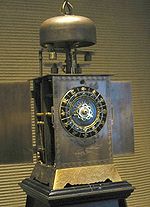
Mechanical clocks were introduced into Japan by Jesuit missionaries
Missionary
A missionary is a member of a religious group sent into an area to do evangelism or ministries of service, such as education, literacy, social justice, health care and economic development. The word "mission" originates from 1598 when the Jesuits sent members abroad, derived from the Latin...
or Dutch
Netherlands
The Netherlands is a constituent country of the Kingdom of the Netherlands, located mainly in North-West Europe and with several islands in the Caribbean. Mainland Netherlands borders the North Sea to the north and west, Belgium to the south, and Germany to the east, and shares maritime borders...
merchants in the sixteenth century. These clocks were of the lantern clock
Lantern clock
A lantern clock is a type of antique weight-driven wall clock, shaped like a lantern. They were the first type of clock widely used in private homes. They probably originated before 1500 but only became common after 1600; in Britain around 1620. They became obsolete in the 19th century.- Origin...
design, typically made of brass
Brass
Brass is an alloy of copper and zinc; the proportions of zinc and copper can be varied to create a range of brasses with varying properties.In comparison, bronze is principally an alloy of copper and tin...
or iron
Iron
Iron is a chemical element with the symbol Fe and atomic number 26. It is a metal in the first transition series. It is the most common element forming the planet Earth as a whole, forming much of Earth's outer and inner core. It is the fourth most common element in the Earth's crust...
, and used the relatively primitive verge and foliot escapement
Escapement
In mechanical watches and clocks, an escapement is a device that transfers energy to the timekeeping element and enables counting the number of oscillations of the timekeeping element...
. These led to the development of an original Japanese clock, called Wadokei.
Neither the pendulum
Pendulum
A pendulum is a weight suspended from a pivot so that it can swing freely. When a pendulum is displaced from its resting equilibrium position, it is subject to a restoring force due to gravity that will accelerate it back toward the equilibrium position...
nor the balance spring
Balance spring
A balance spring, or hairspring, is a part used in mechanical timepieces. The balance spring, attached to the balance wheel, controls the speed at which the wheels of the timepiece turn, and thus the rate of movement of the hands...
were in use among European clocks of the period, and as such they were not included among the technologies available to the Japanese clockmakers at the start of the isolationist period
Sakoku
was the foreign relations policy of Japan under which no foreigner could enter nor could any Japanese leave the country on penalty of death. The policy was enacted by the Tokugawa shogunate under Tokugawa Iemitsu through a number of edicts and policies from 1633–39 and remained in effect until...
in Japanese history
History of Japan
The history of Japan encompasses the history of the islands of Japan and the Japanese people, spanning the ancient history of the region to the modern history of Japan as a nation state. Following the last ice age, around 12,000 BC, the rich ecosystem of the Japanese Archipelago fostered human...
, which began in 1641. Later Japanese clock makers introduced more sophisticated clock technology through the Dutch, leading to spectacular developments such as the Universal Myriad year clock
Myriad year clock
The , was a universal clock designed by the Japanese inventor Hisashige Tanaka in 1851. It belongs to the category of Japanese clocks called Wadokei. This clock is designated as an Important Cultural Asset by Japanese government....
designed in 1850 by Tanaka Hisashige, the founder of what would become the Toshiba
Toshiba
is a multinational electronics and electrical equipment corporation headquartered in Tokyo, Japan. It is a diversified manufacturer and marketer of electrical products, spanning information & communications equipment and systems, Internet-based solutions and services, electronic components and...
corporation.
Pumps

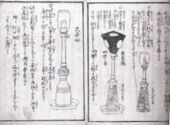

Robert Boyle
Robert Boyle FRS was a 17th century natural philosopher, chemist, physicist, and inventor, also noted for his writings in theology. He has been variously described as English, Irish, or Anglo-Irish, his father having come to Ireland from England during the time of the English plantations of...
. In Japan, the first description of a vacuum pump
Vacuum pump
A vacuum pump is a device that removes gas molecules from a sealed volume in order to leave behind a partial vacuum. The first vacuum pump was invented in 1650 by Otto von Guericke.- Types :Pumps can be broadly categorized according to three techniques:...
appear in Aoji Rinsō’s 1825 , and slightly later both pressure pumps and void pumps appear in Udagawa Shinsai’s 1834 . These mechanisms were used to demonstrate the necessity of air for animal life and combustion, typically by putting a lamp or a small pump in a vacuum, and were also used to make calculations of pressure and air density.
Many practical applications were found as well, such as in the manufacture of air gun
Air gun
An air gun is a rifle , pistol , or shotgun that fires projectiles by means of compressed air or other gas, in contrast to a firearm, which burns a propellant. Most air guns use metallic projectiles as ammunition. Air guns that only use plastic projectiles are classified as airsoft...
s by Kunitomo Ikkansai
Kunitomo Ikkansai
was a Japanese gun manufacturer of the early 19th century, who, after having spent several months in Edo where he could get accustomed with Dutch wares, built Japan's first reflective telescope in 1831. It was of the Gregorian type....
, after he repaired and analyzed the mechanism of some Dutch air guns which had been offered to the Shogun
Shogun
A was one of the hereditary military dictators of Japan from 1192 to 1867. In this period, the shoguns, or their shikken regents , were the de facto rulers of Japan though they were nominally appointed by the emperor...
in Edo
Edo
, also romanized as Yedo or Yeddo, is the former name of the Japanese capital Tokyo, and was the seat of power for the Tokugawa shogunate which ruled Japan from 1603 to 1868...
. A rather vast industry of also developed, also derived by Kunitomo from the mechanism of air guns, in which oil was continuously supplied through a compressed air mechanism. Kunitomo also developed agricultural applications of these technologies, such as a giant pump powered by an ox
Ox
An ox , also known as a bullock in Australia, New Zealand and India, is a bovine trained as a draft animal. Oxen are commonly castrated adult male cattle; castration makes the animals more tractable...
, to lift irrigation water.
Aerial knowledge and experiments
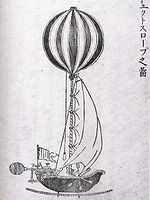
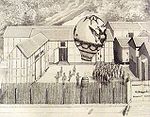
Hot air balloon
The hot air balloon is the oldest successful human-carrying flight technology. It is in a class of aircraft known as balloon aircraft. On November 21, 1783, in Paris, France, the first untethered manned flight was made by Jean-François Pilâtre de Rozier and François Laurent d'Arlandes in a hot air...
by the brothers Montgolfier in France in 1783, was reported less than four years later by the Dutch in Dejima, and published in the 1787 Sayings of the Dutch.
In 1805, almost twenty years later, the Swiss
Switzerland
Switzerland name of one of the Swiss cantons. ; ; ; or ), in its full name the Swiss Confederation , is a federal republic consisting of 26 cantons, with Bern as the seat of the federal authorities. The country is situated in Western Europe,Or Central Europe depending on the definition....
Johann Caspar Horner
Johann Caspar Horner
Johann Caspar Horner was a Swiss physicist and astronomer.In 1805 Johann Caspar Horner visited Japan with the Prussian Georg Heinrich von Langsdorff, as a scientist to the Kruzenshtern mission that also brought the Russian ambassador Nikolai Rezanov to Japan.Horner made a hot air balloon out of...
and the Prussia
Prussia
Prussia was a German kingdom and historic state originating out of the Duchy of Prussia and the Margraviate of Brandenburg. For centuries, the House of Hohenzollern ruled Prussia, successfully expanding its size by way of an unusually well-organized and effective army. Prussia shaped the history...
n Georg Heinrich von Langsdorff, two scientists of the Kruzenshtern
Adam Johann von Krusenstern
Adam Johann Ritter von Krusenstern , was an admiral and explorer, who led the first Russian circumnavigation of the globe.- Life :...
mission that also brought the Russian ambassador Nikolai Rezanov
Nikolai Rezanov
Nikolay Petrovich Rezanov was a Russian nobleman and statesman who promoted the project of Russian colonization of Alaska and California. One of the ten barons of Russia, he was the first Russian ambassador to Japan , and participated in the first Russian circumnavigation of the globe ,...
to Japan, made a hot air balloon out of Japanese paper (washi
Washi
is a type of paper made in Japan. Washi is commonly made using fibers from the bark of the gampi tree, the mitsumata shrub , or the paper mulberry, but also can be made using bamboo, hemp, rice, and wheat...
), and made a demonstration of the new technology in front of about 30 Japanese delegates.
Hot air balloons would mainly remain curiosities, becoming the object of numerous experiments and popular depictions, until the development of military usages during the early Meiji era.
Steam engines
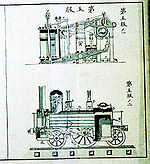


Steam engine
A steam engine is a heat engine that performs mechanical work using steam as its working fluid.Steam engines are external combustion engines, where the working fluid is separate from the combustion products. Non-combustion heat sources such as solar power, nuclear power or geothermal energy may be...
started to spread in Japan during the first half of the 19th century, although the first recorded attempts at manufacturing one date to the efforts of Tanaka Hisashige in 1853, following the demonstration of a steam engine by the Russian embassy of Yevfimy Putyatin
Yevfimy Putyatin
Yevfimy Vasilyevich Putyatin was a Russian admiral noted for his diplomatic missions to Japan and China which resulted in the signing of the Treaty of Shimoda in 1855.-Early life:...
after his arrival in Nagasaki on August 12, 1853.
The Rangaku scholar Kawamoto Kōmin completed a book named in 1845, which was finally published in 1854 as the need to spread Western knowledge became even more obvious with Commodore Perry’s opening of Japan
Convention of Kanagawa
On March 31, 1854, the or was concluded between Commodore Matthew C. Perry of the U.S. Navy and the Tokugawa shogunate.-Treaty of Peace and Amity :...
and the subsequent increased contact with industrial Western nations. The book contains detailed descriptions of steam engines and steamships. Kawamoto had apparently postponed the book’s publication due to the Bakufu’s prohibition against the building of large ships.
Geography
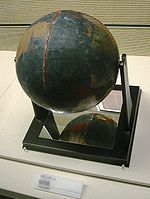
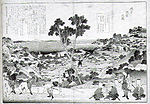

Matteo Ricci
Matteo Ricci, SJ was an Italian Jesuit priest, and one of the founding figures of the Jesuit China Mission, as it existed in the 17th-18th centuries. His current title is Servant of God....
. This knowledge was regularly updated through information received from the Dutch, so that Japan had an understanding of the geographical world roughly equivalent to that of contemporary Western countries. With this knowledge, Shibukawa Shunkai made the first Japanese globe
Globe
A globe is a three-dimensional scale model of Earth or other spheroid celestial body such as a planet, star, or moon...
in 1690.
Throughout the 18th and 19th centuries, considerable efforts were made at surveying
Surveying
See Also: Public Land Survey SystemSurveying or land surveying is the technique, profession, and science of accurately determining the terrestrial or three-dimensional position of points and the distances and angles between them...
and mapping
Cartography
Cartography is the study and practice of making maps. Combining science, aesthetics, and technique, cartography builds on the premise that reality can be modeled in ways that communicate spatial information effectively.The fundamental problems of traditional cartography are to:*Set the map's...
the country, usually with Western techniques and tools. Numerous map
Map
A map is a visual representation of an area—a symbolic depiction highlighting relationships between elements of that space such as objects, regions, and themes....
s of Japan were made; thanks to the up-to-date methods, they do not significantly differ in accuracy with modern ones, just like contemporary maps of European lands.
Biology

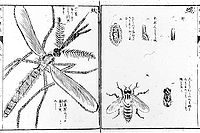

Philipp Franz von Siebold
Philipp Franz Balthasar von Siebold was a German physician and traveller. He was the first European to teach Western medicine in Japan...
(a German doctor in the service of the Dutch at Dejima). Itō Keisuke
Keisuke Ito
was a Japanese physician and biologist. He was born in Nagoya. He studied Western science under Philipp Franz von Siebold during the 1820s.As a doctor, Ito developed a vaccination against smallpox. He also widely studied the Japanese flora and fauna with Philipp Franz von Siebold , the author of...
created numerous books describing animal species of the Japanese islands, with drawings of a near photographic quality.
Entomology
Entomology
Entomology is the scientific study of insects, a branch of arthropodology...
was also extremely popular, and details about insects, often obtained through the use of microscopes (see above), were widely publicized.
In a rather rare case of “reverse Rangaku” (that is, the science of isolationist Japan making its way to the West), an 1803 treatise on the raising of silk worms and manufacture of silk
Silk
Silk is a natural protein fiber, some forms of which can be woven into textiles. The best-known type of silk is obtained from the cocoons of the larvae of the mulberry silkworm Bombyx mori reared in captivity...
, the was brought to Europe by von Siebold and translated into French and Italian in 1848, contributing to the development of the silk industry in Europe.
Various plants were also introduced
Introduced species
An introduced species — or neozoon, alien, exotic, non-indigenous, or non-native species, or simply an introduction, is a species living outside its indigenous or native distributional range, and has arrived in an ecosystem or plant community by human activity, either deliberate or accidental...
to Japan via the Dutch, such as the cabbage
Cabbage
Cabbage is a popular cultivar of the species Brassica oleracea Linne of the Family Brassicaceae and is a leafy green vegetable...
and the tomato
Tomato
The word "tomato" may refer to the plant or the edible, typically red, fruit which it bears. Originating in South America, the tomato was spread around the world following the Spanish colonization of the Americas, and its many varieties are now widely grown, often in greenhouses in cooler...
.
Various other publications
- Automatons: , 1730.
- Mathematics: .
- Optics: .
- Glass-making: .
- Military: , by Takano ChōeiTakano Choeiwas a prominent scholar of Rangaku of the late Edo period.Chōei was born as Gotō Kyōsai, the third son of Gotō Sōsuke who was a middle ranking samurai in Mizusawa Domain of Mutsu Province which is in present-day Iwate Prefecture...
concerning the tactics of the Prussian ArmyPrussian ArmyThe Royal Prussian Army was the army of the Kingdom of Prussia. It was vital to the development of Brandenburg-Prussia as a European power.The Prussian Army had its roots in the meager mercenary forces of Brandenburg during the Thirty Years' War...
, 1850. - Description of the method of amalgamAmalgam (chemistry)An amalgam is a substance formed by the reaction of mercury with another metal. Almost all metals can form amalgams with mercury, notable exceptions being iron and platinum. Silver-mercury amalgams are important in dentistry, and gold-mercury amalgam is used in the extraction of gold from ore.The...
for gold platingGold platingGold plating is a method of depositing a thin layer of gold onto the surface of another metal, most often copper or silver , by chemical or electrochemical plating...
in , or in ShinjitaiShinjitaiShinjitai are the forms of kanji used in Japan since the promulgation of the Tōyō Kanji List in 1946. Some of the new forms found in shinjitai are also found in simplified Chinese, but shinjitai is generally not as extensive in the scope of its modification...
, by Inaba Shin'emon, 1781.
Commodore Perry

Convention of Kanagawa
On March 31, 1854, the or was concluded between Commodore Matthew C. Perry of the U.S. Navy and the Tokugawa shogunate.-Treaty of Peace and Amity :...
in 1854, he also brought numerous technological gifts to the Japanese representatives. Among them was a small telegraph, and a small steam train complete with tracks. These were promptly studied by the Japanese as well.
Essentially considering the arrival of Western ships as a threat and a factor for destabilization, the Bakufu ordered several of its fiefs to build warships along Western designs. These ships, such as the Hōō-Maru, the Shouhei-Maru
Japanese warship Shohei Maru
Shōhei Maru was Japan's first Western-style warship following the country's period of seclusion. She was ordered in 1852 by the government of the Shogun to the southern fief of Satsuma in the island of Kyūshū, in anticipation of the announced mission of Commodore Perry in 1853.The ship was...
, and the Asahi-Maru
Japanese warship Asahi Maru
The Asahi Maru was one of the first Western-style sail warships of Japan following the period of Seclusion. She was ordered by the Tokugawa bakufu to the fief of Mito, her construction started in 1854, and she was completed in 1856....
, were designed and built, mainly based on Dutch books and plans. Some were built within a mere year or two of Perry’s visit. Similarly, steam engines were immediately studied. Tanaka Hisashige, who had made the Myriad year clock
Myriad year clock
The , was a universal clock designed by the Japanese inventor Hisashige Tanaka in 1851. It belongs to the category of Japanese clocks called Wadokei. This clock is designated as an Important Cultural Asset by Japanese government....
, created Japan’s first steam engine, based on Dutch drawings and the observation of a Russian steam ship in Nagasaki in 1853. These developments led to the Satsuma fief building Japan’s first steam ship, the Unkō-Maru, in 1855, barely two years after Japan’s first encounter with such ships in 1853 during Perry’s visit.
In 1858, the Dutch officer Kattendijke would comment:
Last phase of “Dutch” learning
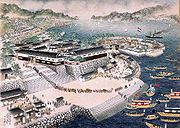
Nagasaki Naval Training Center
The was a naval training institute, between 1855 when it was established by the government of the Tokugawa shogunate, until 1859, when it was transferred to Tsukiji in Edo....
was established in 1855 right at the entrance of the Dutch trading post of Dejima
Dejima
was a small fan-shaped artificial island built in the bay of Nagasaki in 1634. This island, which was formed by digging a canal through a small peninsula, remained as the single place of direct trade and exchange between Japan and the outside world during the Edo period. Dejima was built to...
, allowing for maximum interaction with Dutch naval knowledge. From 1855 to 1859, education was directed by Dutch naval officers, before the transfer of the school to Tsukiji
Tsukiji
Tsukiji is a district of Chūō, Tokyo, Japan, the site of the Tsukiji fish market. Literally meaning "reclaimed land," it lies near the Sumida River on land reclaimed from Tokyo Bay in the 18th century, during the Edo period....
in Tokyo
Tokyo
, ; officially , is one of the 47 prefectures of Japan. Tokyo is the capital of Japan, the center of the Greater Tokyo Area, and the largest metropolitan area of Japan. It is the seat of the Japanese government and the Imperial Palace, and the home of the Japanese Imperial Family...
, where English educators became prominent.

Kanko Maru
The was Japan's first steam warship. The ship was a 3-masted top sail schooner , with an auxiliary coal-fired steam engine turning a side paddlewheel...
, given by the government of the Netherlands
Netherlands
The Netherlands is a constituent country of the Kingdom of the Netherlands, located mainly in North-West Europe and with several islands in the Caribbean. Mainland Netherlands borders the North Sea to the north and west, Belgium to the south, and Germany to the east, and shares maritime borders...
the same year, which may be one of the last great contributions of the Dutch to Japanese modernization, before Japan opened itself to multiple foreign influences. The future Admiral Enomoto Takeaki
Enomoto Takeaki
Viscount was a samurai and admiral of the Tokugawa navy of Bakumatsu period Japan, who remained faithful to the Tokugawa shogunate who fought against the new Meiji government until the end of the Boshin War...
was one of the students of the Training Center. He was also sent to the Netherlands for five years (1862–f67), with several other students, to develop his knowledge of naval warfare, before coming back to become the Admiral of the Shogun’s fleet.
Enduring influence of Rangaku
Numerous scholars of Rangaku continued to play a key role in the modernization of Japan. Scholars such as Fukuzawa YukichiFukuzawa Yukichi
was a Japanese author, writer, teacher, translator, entrepreneur and political theorist who founded Keio University. His ideas about government and social institutions made a lasting impression on a rapidly changing Japan during the Meiji Era...
, Ōtori Keisuke
Otori Keisuke
was a Japanese military commander during the last years of the Tokugawa shogunate and the beginning of the Meiji Era.-Early life and education:Ōtori Keisuke was born in Akamatsu Village, in the Akō domain of Harima Province , the son of physician Kobayashi Naosuke...
, Yoshida Shōin
Yoshida Shoin
Yoshida Shōin was one of the most distinguished intellectuals in the closing days of the Tokugawa shogunate...
, Katsu Kaishu
Katsu Kaishu
was a Japanese statesman, naval engineer during the Late Tokugawa shogunate and early Meiji period. Kaishū was a nickname which he took from a piece of calligraphy by Sakuma Shōzan. He went through a series of given names throughout his life; his childhood name was and his real name was...
, and Sakamoto Ryōma
Sakamoto Ryoma
was a leader of the movement to overthrow the Tokugawa shogunate during the Bakumatsu period in Japan. Ryōma used the alias .- Early life :Ryōma was born in Kōchi, of Tosa han . By the Japanese calendar, this was the sixth year of Tenpō...
built on the knowledge acquired during Japan’s isolation and then progressively shifted the main language of learning from Dutch
Dutch language
Dutch is a West Germanic language and the native language of the majority of the population of the Netherlands, Belgium, and Suriname, the three member states of the Dutch Language Union. Most speakers live in the European Union, where it is a first language for about 23 million and a second...
to English
English language
English is a West Germanic language that arose in the Anglo-Saxon kingdoms of England and spread into what was to become south-east Scotland under the influence of the Anglian medieval kingdom of Northumbria...
.
As these Rangaku scholars usually took a pro-Western stance, which was in line with the policy of the Bakufu but against anti-foreign imperialistic movements, several were assassinated, such as Sakuma Shōzan
Sakuma Shozan
sometimes called Sakuma Zōzan, was a Japanese politician and scholar of the Edo era. He was the son of a samurai, and a native of Shinshu in today's Nagano-ken.From the age of 23, he went to Edo and for 10 years studied Chinese sciences ....
in 1864 and Sakamoto Ryōma
Sakamoto Ryoma
was a leader of the movement to overthrow the Tokugawa shogunate during the Bakumatsu period in Japan. Ryōma used the alias .- Early life :Ryōma was born in Kōchi, of Tosa han . By the Japanese calendar, this was the sixth year of Tenpō...
in 1867.
Notable scholars
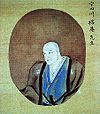
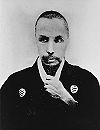
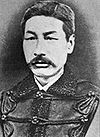
- Arai HakusekiArai Hakusekiwas a Confucianist, scholar-bureaucrat, academic, administrator, writer and politician in Japan during the middle of the Edo Period, who advised the Shogun Tokugawa Ienobu. His personal name was Kinmi or Kimiyoshi . Hakuseki was his pen name...
, author of Sairan IgenSairan IgenThe is a five-volume geography by Japanese Confucian philosopher, government official, and poet Arai Hakuseki . Completed in 1713, it the first work of world geography published in Japan...
and Seiyō KibunSeiyo KibunThe is a 3-volume study of the Occident by Japanese politician and scholar Arai Hakuseki based on conversations with Italian missionary Giovanni Battista Sidotti.... - Aoki Kon'yō
- Maeno Ryōtaku
- Yoshio KōgyūYoshio Kosaku, also known as was a Japanese physician and scholar of "Dutch studies" , and the chief Dutch translator in Nagasaki, often accompanying Dutch East India Company officials on missions to Edo and other official business....
- Ono Ranzan , author of .
- Hiraga GennaiHiraga Gennaiwas an Edo period Japanese pharmacologist, student of Rangaku, physician, author, painter and inventor who is well known for his Erekiteru , Kandankei and Kakanpu...
proponent of the “ElekiterElekiterThe is the Japanese name for a type of generator of static electricity used for electric experiments in the 18th century. In Japan, Hiraga Gennai presented his own elekiter in 1776, derived from an elekiter from Holland...
” - Gotō Gonzan
- Kagawa Shūan
- Sugita GenpakuSugita Genpakuwas a Japanese scholar who was known for his translation of Kaitai Shinsho .Besides Kaitai Shinsho, he also authored Rangaku Kotohajime ....
author of . - Asada Gōryū
- Motoki Ryōei , author of
- Shiba KōkanShiba Kokan, born Suzuki Harushige , was a Japanese painter and printmaker of the Edo period, famous both for his Western-style yōga paintings, in imitation of Dutch oil painting styles, methods, and themes, which he painted as Kōkan, and his ukiyo-e prints, primarily forgeries of the works of Suzuki...
, painter. - Shizuki Tadao , author of , 1798.
- Hanaoka SeishūHanaoka Seishuwas a Japanese surgeon of the Edo period with a knowledge of Chinese herbal medicine, as well as Western surgical techniques he had learned through Rangaku...
, author of the first general anaesthesia. - Takahashi Yoshitoki
- Motoki Shōei
- Udagawa Genshin , author of .
- Aoji Rinsō , author of , 1825.
- Hoashi Banri , author of .
- Takahashi Kageyasu
- Matsuoka Joan
- Udagawa Yōan , author of and
- Itō KeisukeKeisuke Itowas a Japanese physician and biologist. He was born in Nagoya. He studied Western science under Philipp Franz von Siebold during the 1820s.As a doctor, Ito developed a vaccination against smallpox. He also widely studied the Japanese flora and fauna with Philipp Franz von Siebold , the author of...
, author of - Takano ChōeiTakano Choeiwas a prominent scholar of Rangaku of the late Edo period.Chōei was born as Gotō Kyōsai, the third son of Gotō Sōsuke who was a middle ranking samurai in Mizusawa Domain of Mutsu Province which is in present-day Iwate Prefecture...
, physician, dissident, co-translator of a book on the tactics of the Prussian ArmyPrussian ArmyThe Royal Prussian Army was the army of the Kingdom of Prussia. It was vital to the development of Brandenburg-Prussia as a European power.The Prussian Army had its roots in the meager mercenary forces of Brandenburg during the Thirty Years' War...
, , 1850. - Ōshima TakatōŌshima TakatōŌshima Takatō was a Japanese engineer who created the first reverberation blast furnace and first Western-style gun in Japan....
, engineer — established the first western style blast furnace and made the first Western-style cannon in Japan. - Kawamoto Kōmin , author of , completed in 1845, published in 1854.
- Ogata Kōan , founder of the TekijukuTekijukuTekijuku was a school established in Senba Osaka, in 1838 during the Tenpō era of the late Edo period. Its founder was Ogata Kōan, a doctor and scholar of Dutch studies...
, and author of , Japan’s first treatise on the subject. - Sakuma ShōzanSakuma Shozansometimes called Sakuma Zōzan, was a Japanese politician and scholar of the Edo era. He was the son of a samurai, and a native of Shinshu in today's Nagano-ken.From the age of 23, he went to Edo and for 10 years studied Chinese sciences ....
- Hashimoto Sōkichi
- Hazama Shigetomi
- Hirose Genkyō , author of .
- Takeda AyasaburōTakeda Ayasaburo, was a Japanese Rangaku scholar, and the architect of the fortress of Goryōkaku in Hokkaidō.Takeda was born in the Ōzu Domain in 1827. He studied medicine, Western sciences , navigation, military architecture. He was a student of Ogata Kōan and Sakuma Shōzan...
, architect of the fortress of GoryōkakuGoryokakuis a star fort in the city of Hakodate in southern Hokkaidō, Japan. It was the main fortress of the short-lived Republic of Ezo.- History :Built by the Tokugawa shogunate in 1857-1866, it was located in the center of the port of Hakodate, on the island of Hokkaidō... - Ōkuma ShigenobuOkuma ShigenobuMarquis ; was a statesman in the Empire of Japan and the 8th and 17th Prime Minister of Japan...
See also
- Dutch missions to EdoDutch missions to EdoThe Dutch East India Company missions to Edo were regular tribute missions to the court of the Tokugawa Shogun in Edo to reassure the ties between the Bakufu and the Opperhoofd...
- Japanese words of Dutch originJapanese words of Dutch originJapanese words of Dutch origin started to develop when the Dutch East India Company initiated trading in Japan from the factory of Hirado in 1609...
- Japan–Netherlands relationsJapan–Netherlands relationsJapanese–Dutch relations describes the foreign relations between Japan and the Netherlands. Relations between Japan and the Netherlands date back to 1609, when the first formal trade relations were established.-History:...
- Philipp Franz von SieboldPhilipp Franz von SieboldPhilipp Franz Balthasar von Siebold was a German physician and traveller. He was the first European to teach Western medicine in Japan...
- Meiji restorationMeiji RestorationThe , also known as the Meiji Ishin, Revolution, Reform or Renewal, was a chain of events that restored imperial rule to Japan in 1868...
- NakatsuNakatsu, Oitais a city located on the northern border of Ōita Prefecture in Kyūshū, Japan. The city is situated on the border with Fukuoka Prefecture.The city was founded on April 20, 1929. As of 2008, the city has an estimated population of 84,179, with a population density of 171 people per km²...
- Fukuzawa YukichiFukuzawa Yukichiwas a Japanese author, writer, teacher, translator, entrepreneur and political theorist who founded Keio University. His ideas about government and social institutions made a lasting impression on a rapidly changing Japan during the Meiji Era...
- Bansha no gokuBansha no gokuThe Bansha no goku refers to the 1839 suppression of scholars of Western Studies by the Edo Shogunate government of Japan....
- Keio UniversityKeio University,abbreviated as Keio or Keidai , is a Japanese university located in Minato, Tokyo. It is known as the oldest institute of higher education in Japan. Founder Fukuzawa Yukichi originally established it as a school for Western studies in 1858 in Edo . It has eleven campuses in Tokyo and Kanagawa...
- Uki-eUki-eUki-e refers to a genre of Japanese woodblock print that employs western conventions of linear perspective...

